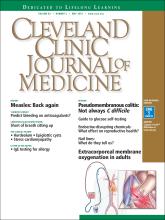Article Figures & Data
Tables
Endocrine-disrupting chemicals may affect how hormones work in our bodies. They are found throughout the environment, and cannot be completely avoided.
To reduce bisphenol A (BPA) exposure for infants
Breastfeed infants for at least 12 months when possible for overall health. If breastfeeding is not an option, it is important to use the formula recommended by your healthcare provider.
But be aware of the following:
Liquid formula in cans contains BPA. A government study showed that powdered formula mix did not contain measurable amounts of BPA.
Use BPA-free containers to prepare infant formula.
As of 2009, the six major makers of infant bottles and feeding cups have not used BPA when manufacturing for the US market. Avoid older bottles and cups if possible.
BPA is found in many items made of plastic, including baby toys. Look for “BPA-free,” although this is not a guarantee, since in some cases BPA has been replaced by similar chemicals. Some but not all plastics marked with recycle code 7 may be made with BPA.
Do not heat foods in containers made with BPA. Hot or boiling liquids can transfer traces of BPA. When possible, avoid micro-waving foods in plastic containers.
Liners of canned food containers are made with BPA. Rinse canned food well, and substitute fresh foods or food in other types of containers when possible.
Do not use cracked or scratched plastics to prepare or contain liquids or solid food. Cracked or scratched plastics that contain BPA are more likely to transfer BPA to liquids and foods.
To minimize pesticide exposure at home
Reduce or eliminate pests through cleaning, home repair, and trapping. Avoid chemical pesticides.Eating fruits and vegetables is important for health
It is more important for health to eat fruits and vegetables than to avoid pesticides by not eating any. To minimize pesticide exposure:
Buy organic for foods with the highest levels of pesticides when grown nonorganically. These include apples, celery, bell peppers, peaches, strawberries, imported nectarines, grapes, spinach, lettuce, cucumbers, domestic blueberries, and potatoes.
Eat foods that are low in pesticides when conventionally grown, including onions, sweet corn, pineapples, avocado, cabbage, sweet peas, asparagus, mangoes, eggplant, kiwi, domestic cantaloupe, sweet potatoes, grapefruit, watermelon, and mushrooms.
Avoid phthalates
Phthalates are found in many personal-care products. Diethyl phthalate, dimethyl phthalate, and dibutyl phthalate are commonly used in deodorants, fragrances, hair sprays, hand and body lotions, and nail polish. Unfortunately, not all products that contain them may list them as an ingredient on the label. Read the label and avoid products containing phthalates. Look for “phthalate-free.”
Plastics with recycle code 3 may contain phthalates.
Avoid flame-retardant chemicals
Fire retardants are often used in polyurethane foam found in items such as couches, upholstered chairs, futons, car seats, crib mattresses, and nap pads.
Endocrine disruption is linked to compounds such as tris (1,3-dichloro-2-propyl) phosphate (TDCPP, also known as chlorinated tris and Firemaster) found in household products, including furniture, appliances, electronics, and baby products.
Reproductive difficulties and developmental delays are linked to some flame retardants.
Older foam products (ie, made before 2005) may be more hazardous.
Buy products without flame retardants.Based on information in references 24–26.
Information from professional associations, academic institutions, community organizations, and government agencies Academic Pediatric Association
Research articles
American Society for Reproductive Medicine
Environment and reproduction special interest group membership information
Research articles
Smoking and infertility
Asian Communities for Reproductive Justice
Safer products and working conditions, specifically in nail salons
Association of Reproductive Health Professionals
Clinical publications
Continuing medical education
Research
California Healthy Nail Salon Collaborative
Improving the health and safety of workers and customers in nail salons
California Teratogen Information Service
Pregnancy risk information
Environmental exposures and reproductive health
Center for Science in the Public Interest
Steps to protect pregnant women from harmful bacteria and parasites in food
Collaborative on Health and the Environment
Chemicals, endocrine disruptors, and reproductive health concerns
Environmental Working Group
Index of chemicals with associated routes of exposure and health effectsMarch of Dimes
Environmental risks and pregnancy
Mercury and reproductive health
Moms Rising
Pesticides and pregnancy
National Institute of Environmental Health Science
How endocrine disruptors work and their effects
US Centers for Disease Control and Prevention
Effects of tobacco, pesticides, and lead on reproductive health and infertility
Diethylstilbestrol update
US Food and Drug Administration
dvice for parents on bisphenol A
University of California San Francisco Program on Reproductive Health and the Environment
Publications on reproductive health related to exposures at work, food and chemical exposure, and toxins in everyday living
Women for a Healthy Environment
dvice on eating habits, exercising, and avoiding certain chemicals for healthier, environmentally safe pregnancies
Women’s Health and the Environment
Information on avoiding polyvinyl chloride, styrene, and polycarbonate to maintain hormonal health
Women’s Voices for the Earth
Chemicals and reproductive health






